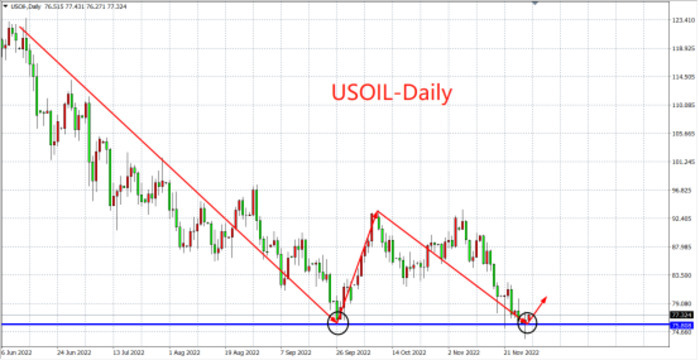OPEC made another big move to cut production? Oil prices usher in a rebound window
 2022-11-29
2022-11-29
 1127
1127
Oil prices climbed to session highs, reversing early losses of more than 3 percent, on expectations that OPEC+ will consider further production cuts when it meets this weekend. WTI crude oil once rose more than 2% to 77.8 US dollars / barrel, and Brent crude oil stood at 84 US dollars / barrel in the intraday session.
OPEC+ output cut expectations heat up
On Monday (November 28), due to the rising risk of global economic recession and the drag of the epidemic control in the world's second largest economy, WTI crude oil once fell to an intraday low of $73.6, the lowest since December 27, 2021. However, oil prices then rebounded and returned to above $76.0, recovering all the intraday losses.
The reason is that at the time when the global economic recession is expected and oil prices continue to fall, market news on Monday (November 28) showed that OPEC+ plans to seriously consider introducing new policies at the ministerial meeting held on Sunday (December 4). Possibility of production reduction measures.
It is worth noting that Saudi Energy Minister Abdulaziz bin Salman last week denied market speculation that OPEC+ would increase production by 500,000 barrels per day. Salman said that the plan to reduce the 2 million barrels will continue until the end of 2023, and if there is a need to "balance supply and demand", then OPEC+ is "ready to intervene".
Societe Generale analyst Michael Haigh said that what is about to happen this week can have a huge impact on the crude oil market and can easily lead prices from one extreme to the other.
Oil prices have fallen by nearly 20% in the past three weeks. With no major central banks tightening policies, the number of new crown cases has increased, and the economic outlook is cloudy, oil demand will face a greater impact next year. OPEC+ is likely to make a decision on whether to cut production after weighing the extent of the damage caused by the G7 price limit on Russian oil to the crude oil market. JPMorgan said OPEC+ would need to cut output by 400,000 bpd next year to balance the market.

EU oil price talks on Russia postponed again
G7's price limit on Russian oil has become an important reference for the market to judge the short-term direction of oil prices. The EU's negotiation on Russian oil price limit has been postponed since last week, because some EU member states worry that the price limit is too low to limit Moscow's implementation in Ukraine Ability to fund special military operations.
It is foreseeable that the EU's price limit on Russian oil will be determined before December 5 in order to cooperate with the EU's oil embargo on Russia. The G7’s final price limit for Russian oil is likely to still fall within the previously set range of US$65-70. As inflation remains high, the G7 not only considers limiting Russia’s war funding sources, but also hopes that Russia will maintain oil flows to avoid global inflation. Prices soared.
The author believes that the focus of the G7 on the Russian oil price limit may be on Russia's response. The Kremlin had previously drafted a presidential decree that would prohibit companies and traders who buy Rosneft from selling oil to any party that caps the price of Rosneft. The problem is that Russia's main crude oil price is currently well below the limit price range of 65-70 US dollars. Ural grade crude at the port of Primorsk fell to $51.96 a barrel, 20 percent below the $65 price ceiling that the G7 may set, according to the data.
RBC commodities strategist Helima Croft said: The oil price cap is not to reduce Russian revenue, but to keep Russian oil in the market. It is foreseeable that the higher oil price limit will not lead to Russia to take production cut measures, while OPEC+ is likely to take further action in this case.
At this stage, oil prices are facing the risk of rebounding in the short term. Whether it is Russia's production cuts or OPEC+ production cuts, it will be conducive to the short-term rebound of oil prices. Investors can focus on the potential rebound of oil prices at the end of this week.

Fed officials frequently "hawk"
The short-term decline in oil prices is unsustainable, but this does not mean that the medium-term decline in oil prices since June is over.
On Monday (November 28), Fed officials once again released a "hawkish" signal. St. Louis Fed President James B. Bullard said that the strength of the labor market provides the basis for the Fed to pursue deflation, and the FOMC needs to raise interest rates to At the low end of the 5.0%-7.0% interest rate range, the Fed will continue to raise interest rates until 2023, and the market has not fully priced in that the Fed may be more aggressive in monetary policy.
John Williams, President of the New York Fed, emphasized that inflation risks are still rising and that restrictive policies need to be maintained until 2023. He also expects the U.S. unemployment rate to rise from 3.7% to 4.5%-5.0% by the end of 2023. Richmond Fed President Thomas Barkin expressed support for a broader but potentially higher rate hike path.
The U.S. dollar is currently stabilizing above 105.0. With the voice of the Fed's "hawks", it cannot be ruled out that the market's earlier bets on the "turning point" of the Fed's monetary policy will further decline. However, the author reminds that whether it is the increase of terminal interest rates or the systemic risks in the financial field, it means that the current situation is still in the stage of "risks outweigh opportunities", and investors should not be too optimistic.
Investors this week can focus on the U.S. core PCE price index for October, released on Thursday (December 1), which is the Fed's preferred inflation indicator. The U.S. PCE price index in September recorded a year-on-year increase of 6.2%, and the core PEC price index increased by 5.1% year-on-year, compared with the expected 6.0% and 5% in October, respectively. In addition, Friday (December 2) will usher in the U.S. October non-agricultural data, in which the unemployment rate and new growth need to be watched by the market. If the non-agricultural data shows that the labor market remains firm, it is expected to provide the possibility for the Fed to take a faster pace than market expectations.
Outlook

The daily chart shows that although WTI crude oil is still in a mid-term decline since June, the decline has slowed down since early November, and the continuous lower shadow line suggests that bulls are focusing on the possibility of a short-term bottom in oil prices.
Oil prices fell to the previous low of 75.80 yesterday and then bottomed out. It is expected to form a double bottom with the previous level (September 26). It is expected to rebound and challenge above the 80 mark.
The above information is provided by special analysts and is for reference only. CM Trade does not guarantee the accuracy, timeliness and completeness of the information content, so you should not place too much reliance on the information provided. CM Trade is not a company that provides financial advice, and only provides services of the nature of execution of orders. Readers are advised to seek relevant investment advice on their own. Please see our full disclaimer.

CM Trade
As a world leading financial trading platform, CMtrade Provides comprehensive one-stop trading services and opportunities for traders.
[Products]
The platform provides over 32 kinds of popular financial products such as forex, precious metals, crude oil, indices, cryptocurrencies and more.
[System]
2 top trading systems CM Trade MT4 / CM Trade APP, powerful and easy to operate
[Service]
Comprehensive market news, professional market analysis, 7*24 hours online customer service
[Advantage]
Low cost, high leverage, flexible one-stop all day two-way trading.
[Authority]
Licensed and strictly regulated by authorities. Traders deposits are independently kept by the bank. Fast deposit and withdrawal. Fair, efficient and transparent trading environment.
CM Trade Mobile Application
Economics Calendar
MoreYou May Also Like



 简体中文
简体中文
 ภาษาไทย
ภาษาไทย
 繁體中文
繁體中文
 Indonesia
Indonesia











